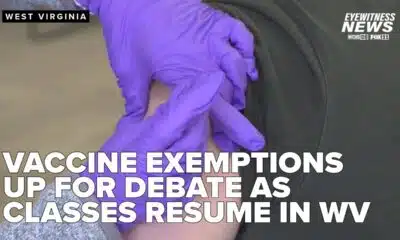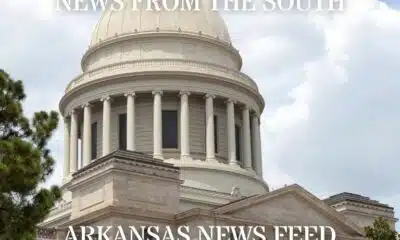News from the South - West Virginia News Feed
Skyrocketing Hope Scholarship price tag, now around $100M, a concern for WV lawmakers making budget
Skyrocketing Hope Scholarship price tag, now around $100M, a concern for WV lawmakers making budget
by Amelia Ferrell Knisely, West Virginia Watch
February 26, 2025
The price tag for the Hope Scholarship, the state’s education savings account program, will double next year, climbing to more than $100 million. As budget concerns loom, lawmakers are questioning if the state can afford the program that is a hallmark of the Republican-heavy Legislature’s education freedom push.
It’s the largest funding increase requested by Gov. Patrick Morrisey in his first budget proposal.
“I believe, based on the information we have so far, which is preliminary, I think there should be a modification to it, but I don’t know what it will be yet to what we’re considering or what we’re going to do,” said House Finance Chair Vernon Criss, R-Wood.
The Hope Scholarship, established in 2021, gives families roughly $4,400 per student in taxpayer money to use for private schools, homeschooling and more. There are limited guardrails on how funds can be used, and West Virginia families have used scholarship funds to pay for tuition at out-of-state schools, iPads, dance studio fees and more.
State Treasurer Larry Pack, who oversees the Hope Scholarship, requested around $100 million to pay for the program and expects to serve more than 19,000 students next year under its current eligibility rules. Program costs this year were around $52 million.
“Each year, more families enroll in the Hope Scholarship program empowering those parents to find the right education that fits their child’s unique needs,” Pack said. “My goal is to ensure that parents and families have the tools necessary to tailor an education for their children that works best for them.”
“The governor did not know the extent of Hope needs and funding until he assumed office,” said Eric Nelson, who Gov. Patrick Morrisey tapped to serve as revenue secretary to tackle the state’s budget challenges. The Republican governor said former Gov. Jim Justice left him a projected $400 million deficit.
Morrisey, who requested a balanced budget in FY 2026, wants to use four different revenue streams to pay for the Hope Scholarship: $29 million in state funds, then a combination of two different lottery funds and a supplemental appropriation to add up to what his office says is a needed $110 million. Pack said the recommended supplementals were necessary for the program to continue to expand.
Senate Finance Chair Jason Barrett, R-Berkeley said the state would use one-time money to pay for the Hope Scholarship this year, adding, “There is always money in lottery and excess lottery.”
Kelly Allen, director of the West Virginia Center on Budget and Policy, noted that the governor requested $170 million in one-time money to cover costs. “A chunk of that is to fully fund Medicaid and the Hope Scholarship,” she said.
“When we look at the governor’s proposed budget, nearly every agency and program sees a flat allocation compared to last year or reductions like in higher education,” Allen continued. “The only program that sees significant growth in the governor’s budget is the Hope Scholarship.”
House Speaker Roger Hanshaw has raised concerns about whether the state can afford the education savings account program. Del. John Williams, D-Monongalia, minority chair of the House Finance Committee, has the same apprehension.
“It’s easy to campaign on these issues and talk about school choice. But when you increase your demands and pass tax decreases at the same time, eventually, that comes home to roost,” Williams said. “It has now, and they’re having trouble.”
Barrett felt confident in the state’s plan to pay for the program.
“I think that the Legislature has made it very clear, based on what we’ve heard from the people across West Virginia, that very much want the Hope Scholarship,” he said. “I think it’s incumbent upon the Legislature now to honor the Hope Scholarship and do these things to make sure that it is funded at 100%.”
Criss emphasized that lawmakers are in the early phases of hammering out the budget.
“We don’t know what the Senate is going to do. Obviously, we want to be prudent,” he said. “We want to be able to do what the law says, but I believe that we’re going to have to look at maybe some kind of a modification.”
House Democrats have proposed curtailing the use of Hope Scholarship funds at out-of-state schools after more than $257,000 was spent last year in 12 other states. Their bill, House Bill 2955, would require that schools receiving the Hope Scholarship must be located in West Virginia.
Program price already causing 2027 budget gap
The Hope Scholarship will open up to all students to participate in the 2026-27 school year, and the Treasurer’s Office estimates that an additional 30,000 to 40,000 students will be eligible. The program will have an estimated $300 million price tag.
Under Morrisey, the state has brought back six-year budget forecasts that went to the wayside under Justice.
Mike McKown, state budget director, said that, as of now, a projected budget gap for 2027 is right below $400 million. “The big drivers are PEIA, Hope [Scholarship] and the school aid formula,” he said.
Williams said the state’s plan to use one-time money for Hope Scholarship presents a challenge next year when the program cost more than doubles.
“The sky’s the limit of how much it’s going to be, and I think that’s a real concern,” he said. “I don’t know what we’re going to do next year.”
When asked if the governor’s office would consider any changes or limits to the Hope Scholarship, Nelson said, “We’ve been awfully busy at this time putting the budget together, the flood situation and putting a team in place. This and specific areas that may need addressed, like PEIA or future taxes, will be forthcoming. I feel confident that we have a great team.”
Hope funding grows as public schools struggle
The multi-million dollar Hope Scholarship funding need comes as a wave of public schools are closing due to financial strain spurred by student population loss. Some students have exited public schools to use the Hope Scholarship.
A key education measure this session is meant to help elementary teachers remove disruptive and violent students, and the bill doesn’t come with any funding to hire specially-trained staff or to build needed alternative learning schools for suspended students.
“We hear from lawmakers all the time there’s no more money to fund behavioral support specials or interventionists,” Allen said, adding that Morrisey figuring out how to pay for the Hope Scholarship showed that money was available.
“Knowing that we haven’t done our due diligence in our free public schools is really concerning,” she said.
YOU MAKE OUR WORK POSSIBLE.
West Virginia Watch is part of States Newsroom, a nonprofit news network supported by grants and a coalition of donors as a 501c(3) public charity. West Virginia Watch maintains editorial independence. Contact Editor Leann Ray for questions: info@westvirginiawatch.com.
The post Skyrocketing Hope Scholarship price tag, now around $100M, a concern for WV lawmakers making budget appeared first on westvirginiawatch.com
News from the South - West Virginia News Feed
Feds direct states to check immigration status of their Medicaid enrollees
by Anna Claire Vollers, West Virginia Watch
August 22, 2025
This week, the Trump administration’s Centers for Medicare & Medicaid Services (CMS) announced an effort to check the immigration status of people who get their health insurance through Medicaid and the Children’s Health Insurance Program.
Medicaid is the public health insurance program for people with low incomes that’s jointly funded by states and the federal government. For families that earn too much to qualify for Medicaid but not enough to afford private insurance, CHIP is a public program that provides low-cost health coverage for their children.
The feds will begin sending states monthly enrollment reports that identify people with Medicaid or CHIP whose immigration or citizenship status can’t be confirmed through federal databases. States are then responsible for verifying the citizenship or immigration status of individuals in those reports. States are expected to take “appropriate actions when necessary, including adjusting coverage or enforcing non-citizen eligibility rules,” according to a CMS press release.
“We are tightening oversight of enrollment to safeguard taxpayer dollars and guarantee that these vital programs serve only those who are truly eligible under the law,” Robert F. Kennedy Jr., who oversees CMS as secretary of the U.S. Department of Health and Human Services, said in a press release announcing the new program.
As of April, roughly 71 million adults and children nationwide have Medicaid coverage, while another 7 million children have insurance through CHIP. Immigrants under age 65 are less likely to be covered by Medicaid than U.S.-born citizens, according to an analysis from health research organization KFF.
Immigrants who are in the country illegally aren’t eligible for federally funded Medicaid and CHIP. Only citizens and certain lawfully present immigrants — green card holders and refugees, for example — can qualify.
But some states have chosen to expand Medicaid coverage for immigrants with their own funds. Twenty-three states offer pregnancy-related care regardless of citizenship or immigration status, according to KFF. Fourteen states provide coverage for children in low-income families regardless of immigration status, while seven states offer coverage to some adults regardless of status.
The tax and spending package President Donald Trump last month cuts federal spending on Medicaid by more than $1 trillion, leaving states to either make up the difference with their own funds or reduce coverage. But the new law also includes restrictions on coverage for certain immigrants, including stripping eligibility from refugees and asylum-seekers.
Stateline reporter Anna Claire Vollers can be reached at avollers@stateline.org.
West Virginia Watch is part of States Newsroom, a nonprofit news network supported by grants and a coalition of donors as a 501c(3) public charity. West Virginia Watch maintains editorial independence. Contact Editor Leann Ray for questions: info@westvirginiawatch.com.
The post Feds direct states to check immigration status of their Medicaid enrollees appeared first on westvirginiawatch.com
Note: The following A.I. based commentary is not part of the original article, reproduced above, but is offered in the hopes that it will promote greater media literacy and critical thinking, by making any potential bias more visible to the reader –Staff Editor.
Political Bias Rating: Centrist
This article provides a balanced overview of recent policy changes to Medicaid and CHIP enrollment verification tied to immigration status. It presents facts, official statements, and statistics without emotive language or partisan framing. Both the rationale behind the policy, such as safeguarding taxpayer dollars, and the impact on immigrants are covered objectively. The inclusion of context on eligibility rules and varying state approaches reinforces a neutral, informative tone, typical of centrist reporting seeking to inform rather than advocate.
News from the South - West Virginia News Feed
Students go back to school in West Virginia, but same education debates rage
by Andrew Donaldson, West Virginia Watch
August 21, 2025
While students across the Mountain State are going back to school to advance to the next grade, many parents and most of the politicians seemed to be held back in the same spots with the same education arguments of the last few years.
News headlines and social media stories come one at a time on the as-needed basis as events and the business model dictate. But separate news items and viral debates over school choice, school funding, school vaccination requirements, school closings, school performance, and school staffing are variations on one theme: What is education, and who should control it?
That basic “who/what” question of intent and control is not unique to education issues. All political stories when reduced to their essences are stories about power and money. Education has become more and more a political endeavour, because of inherently involved power and money. As such, the rules of discerning politics apply far more than the traditional policy ideas and learning philosophies of what information goes into a student and how to evaluate the information coming out of a student. Add in the culture warring elements fueled by the modern marriage of news media and social media, and you have an environment that is heavy on the vibes and light on vocation.
The COVID-19 crisis is justifiably noted to be an inflection point in the push-pull world of policy and politics in general and education specifically. COVID — or more specifically the reaction by the people involved in running the institutions of American society from schools, to government, to health care, to social order — revealed the pre-existing flaws with a stress test that most everyone failed to one degree or another. While the high-minded ideals of learning, education and bettering the next generation were still recited as if the words themselves would magically manifest such things into malleable minds, reality told a different story.
Schools were closed, opened, closed again, re-opened with restrictions and not-ready-for-prime-time hybrid and online learning. Exceptions and standards had to be adjusted on the fly. Parents and the government had a tug-of-war over who could better understand an unprecedented crisis in public health and public trust with in-classroom teachers and their students as the rope.
The generation of students who lived through it heard all the buzzwords and platitudes, but weighed them against their lived experience, and found them wanting. Words said education matters, students matter, learning matters. Actions told them the priority of the education system was to be a giant jobs and funding program first, a daycare for parents second, and once that was all satisfied, perhaps you might learn something while being taught to pass a test to show what you learned.
Post-COVID, plenty of parents and politicians seem unable to let go of the tug-of-war rope. While the individual debates over issues like the vaccine exemptions, the ballooning cost of the Hope Scholarship, and debates over what should and shouldn’t be included in curriculum continue, perspective is badly needed that all these threads form the one cord of systematically educating students. The in-classroom teachers and students are on a treadmill that starts every August and keeps going until the following June. Education in the United States of America in the Year of Our Lord 2025 is very much a machine that does not stop.
The ever-entwined socio-political news and social media coverage of education runs at variable speeds, mostly parallel to the actual in-classroom education system. When the news narratives and social media attention does cross over into the real world education system, chaos and confusion are usually the result. Regardless of the chaos or the reason du jour, the in-classroom teachers have to press ahead with the students. While the algorithms and consultants keep us entertained, the pressure on an already overworked, underfunded and constantly criticized in-classroom environment is doing no one any favors.
Not that there ever was an era of magnanimous politics, but even with cellphones being banned from classrooms the rising generations of students have more information on current events than ever before. Those students aren’t just learning the curriculum; they are learning what the adults — teachers, parents, government officials, administrators — really think about them and their place in the education and political machines that drive America. And they are going to believe us.
GET THE MORNING HEADLINES.
West Virginia Watch is part of States Newsroom, a nonprofit news network supported by grants and a coalition of donors as a 501c(3) public charity. West Virginia Watch maintains editorial independence. Contact Editor Leann Ray for questions: info@westvirginiawatch.com.
The post Students go back to school in West Virginia, but same education debates rage appeared first on westvirginiawatch.com
Note: The following A.I. based commentary is not part of the original article, reproduced above, but is offered in the hopes that it will promote greater media literacy and critical thinking, by making any potential bias more visible to the reader –Staff Editor.
Political Bias Rating: Center-Left
The content presents a critical view of the current education system, highlighting systemic issues such as underfunding, politicization, and the impact of COVID-19 on schooling. It emphasizes the struggles of teachers and students within a politicized environment and calls for broader perspective and reform. While it critiques both political sides and the media’s role, the focus on social challenges and institutional shortcomings aligns more closely with center-left perspectives that advocate for systemic improvements and greater support for public education.
News from the South - West Virginia News Feed
WV groups call on Morrisey, McCuskey to push against end of federal solar program
by Lori Kersey, West Virginia Watch
August 20, 2025
A group of West Virginia environmental organizations is asking state officials to speak against the Trump administration’s move to end a Biden-era solar program that last year committed more than $100 million for projects in West Virginia.
The Environmental Protection Agency terminated the $7 billion Solar for All program earlier this month. The program was intended to help pay for residential solar projects for more than 900,000 lower income U.S. households.
Twelve organizations — including American Friends Service Committee of West Virginia, Appalachian Voices, Christians for the Mountains, and Citizens’ Climate Lobby of West Virginia — sent a letter Tuesday asking Gov. Patrick Morrisey and Attorney General J.B. McCuskey to speak against the program’s cancellation.
“We urge you to use every tool at your disposal to push back against this unwarranted action that will harm families and small businesses across West Virginia,” the organizations wrote.
The EPA granted the West Virginia Office of Energy $106 million in Solar for All funding last year. It also awarded money to 59 other entities.
According to the Office of Energy’s website, the grant was to be used to “deploy residential solar roofs, support home energy efficiency, reduce utility costs for low-income residents, and make West Virginia households more energy resilient.”
The program was scheduled to launch and start construction in 2026, according to a timeline listed on the website.
In a post on the social media platform X on Aug. 7, EPA administrator Lee Zeldin said the Big Beautiful Bill Act, signed into law last month, eliminated the Greenhouse Gas Reduction Fund, which included Solar For All.
“In some cases, your tax dollars were diluted through up to FOUR pass-through entities, each taking their own cut off the top!” Zeldin wrote. “The bottom line is this: EPA no longer has the statutory authority to administer the program or the appropriated funds to keep this boondoggle alive.
“Today, the Trump EPA is announcing that we are ending Solar for All for good, saving US taxpayers ANOTHER $7 BILLION!,” he wrote.
Zeldin said in a video that while the program was stood up in 2024, very little of the program’s money has been spent. Recipients are in the “building and planning phase,” and not the construction process, he said.
A spokesperson for the West Virginia Division of Economic Development, which oversees the Office of Energy, did not immediately respond to an email Monday asking how the local program would be affected by the cancellation and whether or not the state’s grant money had been spent.
In a news release, Quenton King, government affairs specialist for Appalachian Voices, noted that West Virginia officials applied for the funding in 2023, knowing “the value that solar energy brings” to the state.
“The Office of Energy was actively working out how to set the program up for success and lower electricity prices for West Virginia households, and it would be a waste to throw away that work now,” he wrote. “I hope that Gov. Morrisey and A.G. McCuskey work with the administration and our congressional delegation to restore the appropriated and obligated funding for this program.”
Representatives for Morrisey and McCuskey did not immediately respond to an email seeking comment Tuesday.
YOU MAKE OUR WORK POSSIBLE.
West Virginia Watch is part of States Newsroom, a nonprofit news network supported by grants and a coalition of donors as a 501c(3) public charity. West Virginia Watch maintains editorial independence. Contact Editor Leann Ray for questions: info@westvirginiawatch.com.
The post WV groups call on Morrisey, McCuskey to push against end of federal solar program appeared first on westvirginiawatch.com
Note: The following A.I. based commentary is not part of the original article, reproduced above, but is offered in the hopes that it will promote greater media literacy and critical thinking, by making any potential bias more visible to the reader –Staff Editor.
Political Bias Rating: Center-Left
The content presents a focus on environmental protection and opposition to the Trump administration’s termination of a solar energy program aimed at helping low-income households, which aligns with priorities common to center-left perspectives. The article reports concerns from environmental groups and officials about the impact of ending the program but also includes statements from EPA administrator Lee Zeldin explaining the rationale for cancellation, providing some balance. Overall, the piece leans slightly left due to its emphasis on environmental funding and social equity in energy access while maintaining a moderate tone without strong partisan language.
-
News from the South - Florida News Feed7 days ago
Floridians lose tens of millions to romance scams
-
News from the South - Texas News Feed6 days ago
New Texas laws go into effect as school year starts
-
News from the South - Alabama News Feed6 days ago
Final steel girders placed on new Gulf Shores bridge, completion on track
-
News from the South - West Virginia News Feed6 days ago
Religious exemption debate front and center amid new school year in WV
-
News from the South - Arkansas News Feed6 days ago
Trump, Zelenskyy exit White House talks hopeful about security guarantee for Ukraine
-
News from the South - Alabama News Feed6 days ago
Despite federal shift, state health officials encourage COVID vaccines for pregnant women
-
News from the South - Tennessee News Feed7 days ago
Son hopes to get emergency visa following mother's death in East Tennessee
-
News from the South - Alabama News Feed5 days ago
U.S. agriculture secretary announces end to subsidies for solar panels on farmland














































